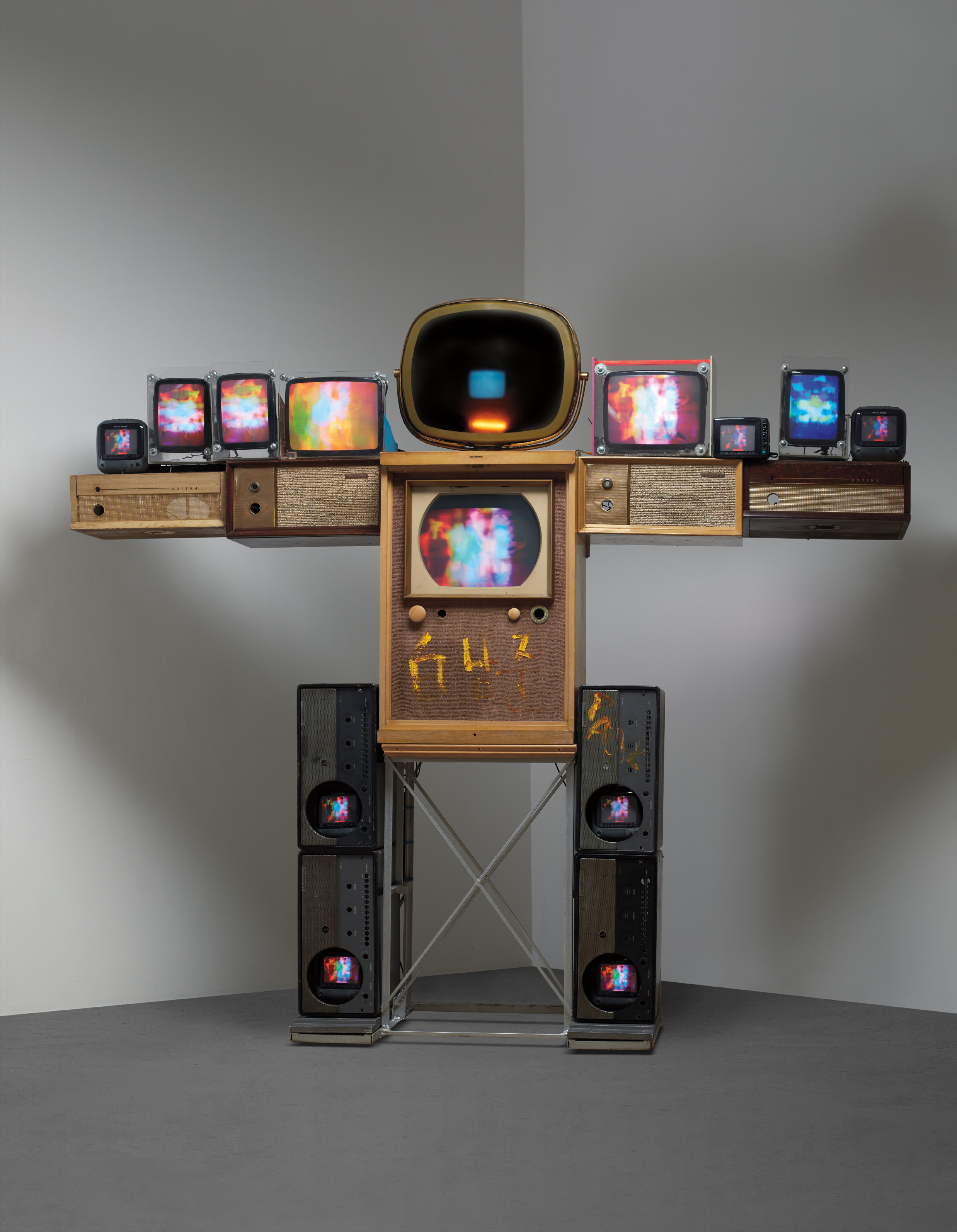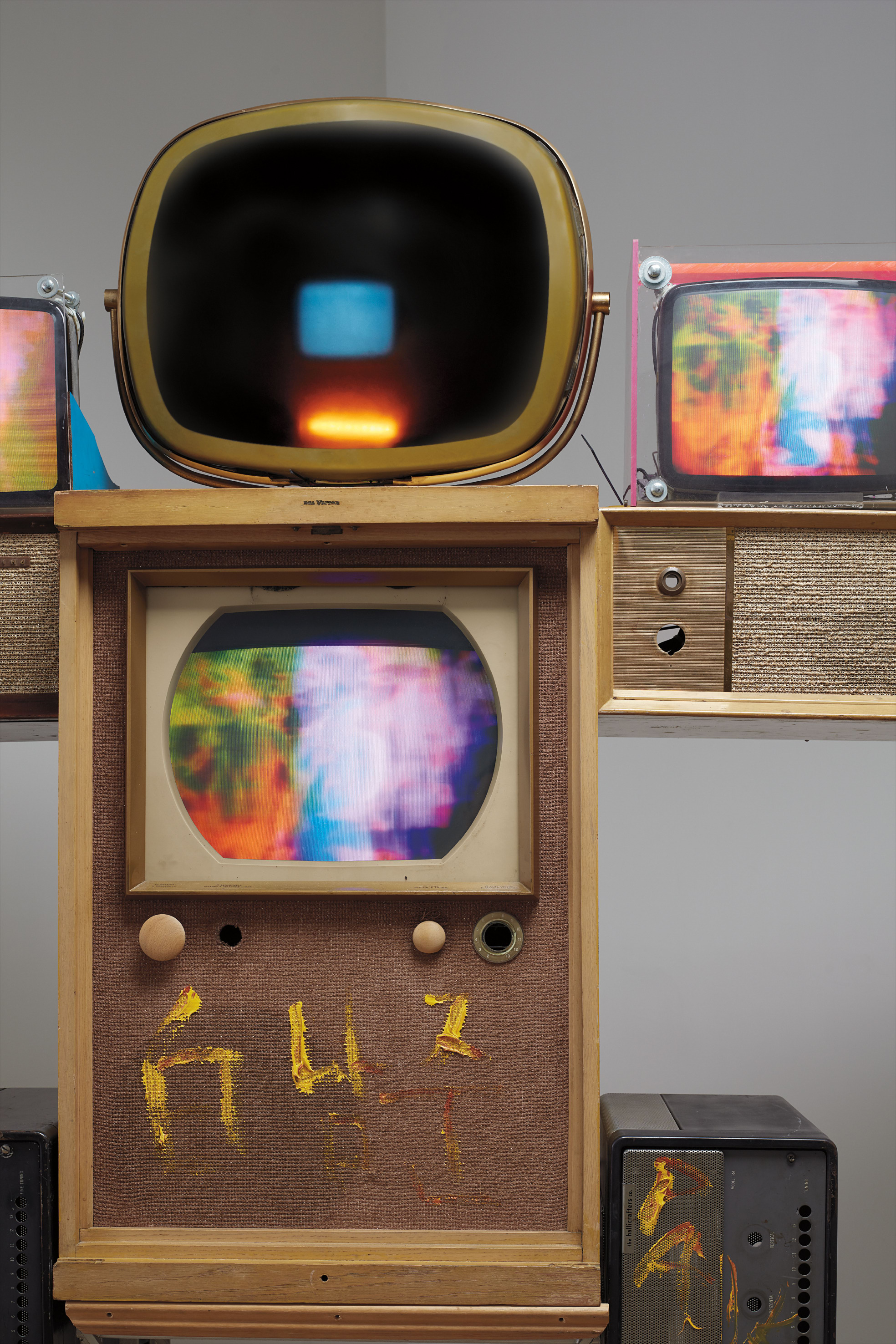





Property of an Important American Collector
44
Nam June Paik
Big Shoulder
signed 'Nam June Paik [in Hanja] PAIK' on the front
mixed media, antique cabinets, televisions, laser disc player and laser disc
233.7 x 264.2 x 45.7 cm (92 x 104 x 17 7/8 in.)
Executed in 1998.
Full-Cataloguing
Towering over the viewer, Big Shoulder is one of Nam June Paik’s now-iconic robots. Executed in 1998, this imposing figure comprises television sets and antique furniture, wedded together to create this impressive monument. With its use of laser discs, the televisions themselves relay images that ensure that this sculpture is dynamic, constantly-changing, animated and almost alive. Paik was one of the great artistic pioneers of the second half of the Twentieth Century, one of the earliest adopters of video art. He was a prominent member of the Fluxus group, and worked alongside some of the most groundbreaking artists of his age, including Joseph Beuys, John Cage and Allan Kaprow. A virtuoso pianist, Paik would often incorporate music into his works, as well as performance in his ‘Happenings’. One of his greatest innovations was his use of televisions and the surrounding video technology, which he harnessed from the 1960s onwards. Paik made clothes and furniture that featured televisions, commenting on the potential of the medium. Big Shoulder continues that exploration of the role of the television, of visual information, in the modern world.
The fusion of the television sets with the antique furniture that has been used to house them and form the bulk of Big Shoulder bridges the past and the present, and introduces the future. This robot continues a theme explored in his 1964 work, Robot K-456, now in the Flick Collection at the Hamburger Bahnhof, Berlin. That work was a skeletal, remote-controlled robot which took its name from a work by Wolfgang Amadeus Mozart. It was designed to walk, move its arms, play clips of speeches made by the recently-assassinated President John F. Kennedy, and even defecated on command, ejecting beans. Paik would return a number of times to the theme of the robot that fuses the anthropomorphic and the technological. For instance, in 1986, he made his Family of Robot, of which the Father and Mother are now in the Nagoya City Art Museum, while the Baby is in the Art Institute of Chicago. While the ‘offspring’ was constructed out of aluminium furniture and television sets to give a ‘newborn’ appearance, the ‘parents’ were made by retasking vintage radio sets and antique furniture, like Big Shoulder. This gives the sculpture a sense of age, weathering and experience that is deliberately at odds with the visual effects on the screens. It reflects Paik’s fascination with the way that new media could link humanity and engage from day to day, bringing about a new change in our interactions with the world.
By the time that Paik made Big Shoulder, he was an internationally-recognised artist. Indeed, in 1993, his exhibition in the German Pavilion at the Venice Biennale had won the Golden Lion. In 1998, he received the highly coveted Kyoto Prize, a distinction received by Roy Lichtenstien, Tadao Ando among many others.
The fusion of the television sets with the antique furniture that has been used to house them and form the bulk of Big Shoulder bridges the past and the present, and introduces the future. This robot continues a theme explored in his 1964 work, Robot K-456, now in the Flick Collection at the Hamburger Bahnhof, Berlin. That work was a skeletal, remote-controlled robot which took its name from a work by Wolfgang Amadeus Mozart. It was designed to walk, move its arms, play clips of speeches made by the recently-assassinated President John F. Kennedy, and even defecated on command, ejecting beans. Paik would return a number of times to the theme of the robot that fuses the anthropomorphic and the technological. For instance, in 1986, he made his Family of Robot, of which the Father and Mother are now in the Nagoya City Art Museum, while the Baby is in the Art Institute of Chicago. While the ‘offspring’ was constructed out of aluminium furniture and television sets to give a ‘newborn’ appearance, the ‘parents’ were made by retasking vintage radio sets and antique furniture, like Big Shoulder. This gives the sculpture a sense of age, weathering and experience that is deliberately at odds with the visual effects on the screens. It reflects Paik’s fascination with the way that new media could link humanity and engage from day to day, bringing about a new change in our interactions with the world.
By the time that Paik made Big Shoulder, he was an internationally-recognised artist. Indeed, in 1993, his exhibition in the German Pavilion at the Venice Biennale had won the Golden Lion. In 1998, he received the highly coveted Kyoto Prize, a distinction received by Roy Lichtenstien, Tadao Ando among many others.